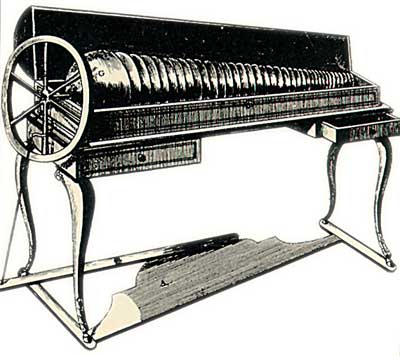

Glass Armonica
A popular entertainment in England in the early 18th century was playing music on upright wine goblets, with tones made by rubbing one's fingers around the lip of glasses filled with different quantities of fluid. In 1761, Franklin created a mechanized version, and called it the Armonica (after the Italian word for harmony.) Franklin worked with London glassblower Charles James to build his Armonica, and it had its world premiere in early 1762, played by Marianne Davies.

Franklin's foot-treadle-operated instrument held 37 glass bowls. The musician touched the rims of the bowls with fingered moistened from the water trough. The bowl-rims were color-coded, according to the note. For example, C's are red, D's orange, E's yellow, etc.
From "The Life of Benjamin Franklin" by Jared Sparks
After many trials he succeeded in constructing an instrument of a different form, more commodious, and more extended in the compass of its notes. His glasses were made in the shape of a hemisphere, with an open neck or socket in the middle, for the purpose of being fixed on an iron spindle. They were then arranged one after another, on this spindle, the largest at one end and gradually diminishing in size to the smallest at the other end. The tones depended on the size of the glasses. The spindle, with its series of glasses, was fixed horizontally in a case, and turned by a wheel attached to its larger end, upon the principle of a common spinning-wheel.
The performer sat in front of the instrument, and the tones were brought out by applying a wet finger to the exterior surface of the glasses as they turned round. He called it the Armonica, in honor of the musical language of the Italians, as he says in a letter to Beccaria, in which it is minutely described. For some time the Armonica was in much use. A Miss Davies acquired great skill in playing upon it. She performed in public, and, accompanied by her sister, who was a singer, she exhibited her skill in the principal cities of Europe, where she attracted large audiences, and the notice of distinguished individuals. The instruments were manufactured in London, and sold at the price of forty guineas each.



